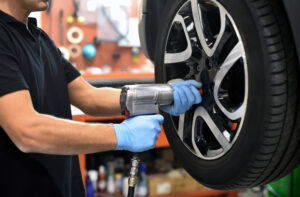Tires play an important role in the safety and performance of your vehicle. As a car owner, it’s essential to know when it’s time to replace your tires to maintain optimal driving conditions. But how do you determine if you need new tires? Here is a guide to help you assess the condition of your tires and make an informed decision about when to replace them.

Tread Depth
Tread depth is one of the most critical factors in determining tire wear. The tread helps provide traction on the road, especially in wet or snowy conditions. Use the “penny test” to measure tread depth: Insert a penny into the tread with Lincoln’s head facing downward. If you can see the top of Lincoln’s head, it indicates that the tread is worn and it’s time for new tires. Alternatively, you can use a tread depth gauge for a more precise measurement. The legal minimum tread depth may vary by jurisdiction, but generally, it is recommended to replace tires when the tread depth reaches 2/32 of an inch (1.6 mm).
Uneven Tread Wear
Inspect your tires for any signs of uneven tread wear. Uneven wear can occur due to various reasons, including improper alignment, underinflation, overinflation, or suspension issues. If you notice significant differences in tread depth between different parts of the tire or across different tires, it may indicate the need for replacement or a professional inspection to address underlying issues.
Cracks, Bulges, or Blisters
Inspect the sidewalls of your tires for any cracks, bulges, or blisters. These can be signs of tire damage or structural weakness, which can lead to tire failure. If you notice any of these issues, it’s recommended to replace the tire immediately, as they compromise the safety and performance of the tire.
Age of the Tires
Even if your tires appear to be in good condition, age can still be a factor in determining the need for replacement. Tires degrade over time, regardless of mileage or tread depth. As a general guideline, most tire manufacturers recommend replacing tires every 6 to 10 years, regardless of their visual condition. Check the sidewall of your tires for a four-digit DOT code that indicates the week and year of manufacture. If your tires are older than 6 to 10 years, it’s advisable to consider replacement, even if they appear to be in good condition.
Driving Conditions and Performance
Consider the driving conditions you encounter regularly. If you live in an area with frequent rainfall or snowfall, it’s crucial to have tires with adequate tread depth to maintain traction. If you notice a significant decrease in wet or snowy road performance, it may indicate the need for new tires. Similarly, if you experience increased noise, vibrations, or a rough ride quality, it could be a sign of tire wear or other tire-related issues.
Tire Replacement From Pit Shop Auto Repair
Regularly assessing the condition of your tires is essential for your safety on the road. If you still need help determining if it’s time to have your tires replaced, Pit Shop Auto Repair in Libertyville, IL, is here to help. As a full-service auto repair shop, we can help drivers maintain their tires with tire balancing and rotating service and replace tires quickly and efficiently. Contact us today to schedule an appointment.
